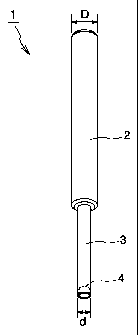Some of the information on this Web page has been provided by external sources. The Government of Canada is not responsible for the accuracy, reliability or currency of the information supplied by external sources. Users wishing to rely upon this information should consult directly with the source of the information. Content provided by external sources is not subject to official languages, privacy and accessibility requirements.
Any discrepancies in the text and image of the Claims and Abstract are due to differing posting times. Text of the Claims and Abstract are posted:
| (12) Patent: | (11) CA 2295258 |
|---|---|
| (54) English Title: | TANG BREAK-OFF TOOL |
| (54) French Title: | OUTIL PERMETTANT D'ENLEVER LES DEBRIS D'UN PIVOT ET/OU TENON |
| Status: | Term Expired - Post Grant Beyond Limit |
| (51) International Patent Classification (IPC): |
|
|---|---|
| (72) Inventors : |
|
| (73) Owners : |
|
| (71) Applicants : |
|
| (74) Agent: | MARKS & CLERK |
| (74) Associate agent: | |
| (45) Issued: | 2009-09-08 |
| (22) Filed Date: | 2000-01-11 |
| (41) Open to Public Inspection: | 2001-02-20 |
| Examination requested: | 2003-12-22 |
| Availability of licence: | N/A |
| Dedicated to the Public: | N/A |
| (25) Language of filing: | English |
| Patent Cooperation Treaty (PCT): | No |
|---|
| (30) Application Priority Data: | ||||||
|---|---|---|---|---|---|---|
|
The present invention provides a tang break-off tool which makes it possible to break off the tang after inserting the spiral coil insert with the tang into the taphole of the work, and further, to easily and with certainty remove the broken tang. The tool has a grip section 2 and an operating section 3, and has a permanent magnet 4 provided at the leading end of the operating section 3.
Le présent instrument consiste en un outil permettant d'enlever les débris d'un tenon; il permet de briser le tenon une fois que la pièce rapportée en spirale a été insérée au moyen du tenon dans le trou du taraud de l'ouvrage et, plus en profondeur, afin d'enlever facilement de façon nette les débris du tenon. L'outil est doté d'un manche (2) et d'une partie opérationnelle (3); il possède également un aimant (4) situé à l'embout avant de la section opérationnelle (3).
Note: Claims are shown in the official language in which they were submitted.
Note: Descriptions are shown in the official language in which they were submitted.

2024-08-01:As part of the Next Generation Patents (NGP) transition, the Canadian Patents Database (CPD) now contains a more detailed Event History, which replicates the Event Log of our new back-office solution.
Please note that "Inactive:" events refers to events no longer in use in our new back-office solution.
For a clearer understanding of the status of the application/patent presented on this page, the site Disclaimer , as well as the definitions for Patent , Event History , Maintenance Fee and Payment History should be consulted.
| Description | Date |
|---|---|
| Inactive: Expired (new Act pat) | 2020-01-13 |
| Common Representative Appointed | 2019-10-30 |
| Common Representative Appointed | 2019-10-30 |
| Grant by Issuance | 2009-09-08 |
| Inactive: Cover page published | 2009-09-07 |
| Inactive: Final fee received | 2009-06-29 |
| Pre-grant | 2009-06-29 |
| Notice of Allowance is Issued | 2009-04-03 |
| Letter Sent | 2009-04-03 |
| Notice of Allowance is Issued | 2009-04-03 |
| Inactive: Approved for allowance (AFA) | 2009-01-31 |
| Amendment Received - Voluntary Amendment | 2008-10-24 |
| Inactive: S.30(2) Rules - Examiner requisition | 2008-04-24 |
| Amendment Received - Voluntary Amendment | 2007-11-22 |
| Inactive: S.30(2) Rules - Examiner requisition | 2007-05-22 |
| Inactive: IPC from MCD | 2006-03-12 |
| Amendment Received - Voluntary Amendment | 2004-06-04 |
| Letter Sent | 2004-01-20 |
| Request for Examination Requirements Determined Compliant | 2003-12-22 |
| All Requirements for Examination Determined Compliant | 2003-12-22 |
| Request for Examination Received | 2003-12-22 |
| Inactive: Entity size changed | 2002-01-07 |
| Application Published (Open to Public Inspection) | 2001-02-20 |
| Inactive: Cover page published | 2001-02-19 |
| Letter Sent | 2000-07-18 |
| Inactive: Single transfer | 2000-06-09 |
| Inactive: First IPC assigned | 2000-03-03 |
| Inactive: IPC assigned | 2000-03-03 |
| Inactive: Courtesy letter - Evidence | 2000-02-15 |
| Inactive: Filing certificate - No RFE (English) | 2000-02-14 |
| Application Received - Regular National | 2000-02-08 |
There is no abandonment history.
The last payment was received on 2008-12-03
Note : If the full payment has not been received on or before the date indicated, a further fee may be required which may be one of the following
Patent fees are adjusted on the 1st of January every year. The amounts above are the current amounts if received by December 31 of the current year.
Please refer to the CIPO
Patent Fees
web page to see all current fee amounts.
Note: Records showing the ownership history in alphabetical order.
| Current Owners on Record |
|---|
| NIPPON SPREW CO., LTD. |
| Past Owners on Record |
|---|
| FUSAHIDE HONDO |